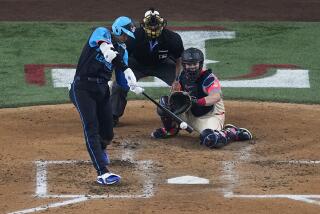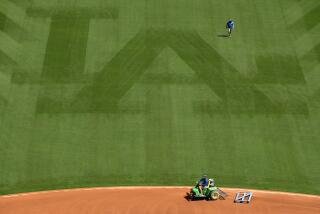For Rookies: Coming to Terms With the Game of Baseball
Some things a beginner might want to know about baseball, with help from “Official Baseball Rules”:
Inning--A unit of baseball. There are nine of them, usually, with each team taking a turn (three outs--see below) in each of them. There is no time clock in baseball.
Base--There are three. The goal is to go from first to second to third (no skipping) and then end up at . . .
Home plate--Where everything starts and ends. Successfully returning here means your team has scored a . . .
Run--The winner is whoever scores the most runs in nine innings (or more if the score is tied after nine; a game cannot end in a tie). If you call them “points,” an usher will summarily eject you.
Infield--It contains the bases and is where the following guys stand:
Pitcher--He throws the ball from a raised area, 60 feet 6 inches from the plate. The raised area is known as “the mound.”
Catcher--The guy the pitcher throws to.
First, second and third basemen--They guard their respective bases.
Shortstop--Nobody’s sure. He stands between the second and third basemen.
Outfield--It’s behind the infield and contains the . . .
Left, center and right fielders--It’s their job to catch any balls not stopped by the guys in the infield, which brings us to the dynamics of . . .
The batter--He stands near the catcher, at home plate, and attempts to hit the baseball, thrown by the pitcher. If he makes contact, he attempts to run to first base or beyond. If he fails to make contact while trying to do so on a ball that has been thrown correctly, it’s known as a . . .
Strike--A measure of batter futility. There are several ways to get a strike, but the basics are: 1) The ball is swung at by the batter and missed. 2) The ball is not swung at but passes through an area known as “the strike zone,” which is the width of the plate and runs vertically from the top of the batter’s knees to “the midpoint between the top of the shoulders and the top of the uniform pants.” 3) The ball is struck but goes “foul” (see below).
Sometimes, the pitcher instead throws a . . .
Ball--This is a pitch that is unsuccessful in that the pitcher failed to get it into the “strike zone.” This success is determined by . . .
The umpires--Four of them, they are the arbiters of the game, determining how everybody’s doing. In addition to balls and strikes, they also decide if the guys trying to get around the bases are . . .
Safe--Getting to a base or home plate without first being touched by the ball, or . . .
Out--This is what you are if you get three strikes, if you are not on a base when touched by an opposing player who has the ball, when a ball you have just batted is caught without first touching the ground, when a ball you have hit on the ground is thrown to first base before you get there or when a ball hit by a teammate while you are on base arrives at the next base before you do (got that?).
Actually, there are many more ways to be out, but these are the ones you’ll see most.
Hit--Successfully hitting the ball to an unoccupied part of the baseball field and getting to a base. You are not credited with a hit if you arrive at the base only because an opposing player made a mistake, known as an . . .
Error--When one of the guys in the infield or outfield messes up.
Single--You get a hit and reach first base ahead of the ball.
Double--Same as a single, but you make it to second.
Triple--You get the idea.
Home run--This means you make it around all three bases and return to home plate, and your team scores a run. Usually achieved by hitting a ball far enough that it reaches the seats and is therefore inaccessible to the outfielders.
Foul ball--A ball that is struck by the bat but lands outside the field of play. For your trouble, you get a strike, unless you already have two. Then you can then swing at and foul as many pitches as you want. You are then known as a “tough out.” You are also known as “boring.”
Walk--If a batter accumulates four balls before he accumulates three strikes, he is invited to take one of these to first base, complements of the opposition.
Stealing--A baserunner need not wait for a teammate to get a hit to advance to the next base. He can simply try to run to it while a pitch is on the way to the plate. When the ball gets to the catcher, he will then try to throw it to the base the opponent is trying to steal. If the runner arrives without first being tagged by the ball, he has “stolen” a base.
Sacrifice--This is when a player does something that results in an out for himself but advances a teammate along the bases. It is sometimes achieved with a . . .
Bunt--Rather than swing the bat, a player attempting to do this successfully just holds the bat in front of him with both hands in an attempt to basically stop the ball and drop it on the grass in front of him. It can be difficult to field, thereby giving the runner already on base time to advance. Some of the best at this can actually beat the throw to first and bunt for hits. A really bad bunt, however, can lead to a . . .
Double play--This is when two outs are made on one batted ball. There are a number of zany ways to achieve this, but here is the most basic: Man on first. Ball batted into play. A fielder throws to second, beating the runner, and the ball is then relayed to first ahead of the batter. Both are out.
Triple play--Three outs “as a result of continuous action” on one batted ball. Extremely rare. If you see one, tell your friends.
Fly ball--A ball hit high into the air.
Sacrifice fly--Different than a sacrifice. In this case, a man is on third base. The batter hits a fly ball to the outfield. The man on third must first see that the ball is caught by an outfielder. He can then touch third base (known as “tagging up”) and try to run home. The outfielder will try to beat him there with a throw. This often results in an exciting play, perhaps a monumental collision between the runner and the catcher.
Line drive--A ball hit off the ground, hard and on basically a straight line.
Grounder--A ball that is struck and lands on the ground soon after leaving the bat.
Designated hitter--In the National League--to which the Dodgers belong--pitchers also bat. The American League--to which the Angels belong--instead uses one of these. It is a player who has only one job: to bat in place of the pitcher. The theory is that pitchers are usually very bad at the plate, and this will add some offensive excitement. The innovation has also extended the careers of some older players, who do not need to exert themselves on defense. While their teammates are on the field, these guys remain in . . .
The dugout--A kind of open shack where the team members, except for some pitchers, sit. Along with the players sits . . .
The manager--The team’s on-the-field boss. Do not call him coach. In baseball, a coach is an assistant to the manager. Two of them stand on the field, at first and third base, when their team is batting and tell the baserunners how to run the bases.
Bullpen--An area beyond the outfield where a pitcher who might be called upon to pitch later in the game waits it out. When the time comes, there is a mound and plate so the pitcher can warm up. Such a late-inning helper is known as . . .
Reliever--A pitcher who replaces another during the game. This has become an increasingly important role. Some relievers are paid millions of dollars to come in and throw five or six pitches and go home. Sounds like great work if you can get it, but because relievers often come in with men on base and the game on the line, this job requires nerves of steel.
Pinch-hitter--If it is your turn at bat and you have done badly or aren’t suited to the game situation or the opposition’s pitcher, your manager will ask you to take a seat in the dugout and send up one of these. The pinch-hitter takes your at-bat for you. Once you are out of the game, you aren’t allowed to return.
Seventh-inning stretch--The home crowd stands and sings “Take Me Out to the Ballgame” after one half of the seventh inning. It’s just a weird tradition. You’ll find baseball has a lot of those.
More to Read
Go beyond the scoreboard
Get the latest on L.A.'s teams in the daily Sports Report newsletter.
You may occasionally receive promotional content from the Los Angeles Times.










